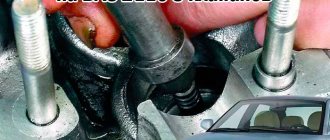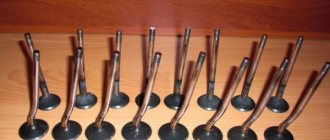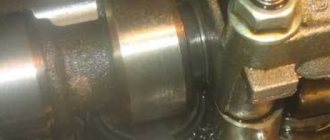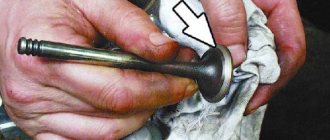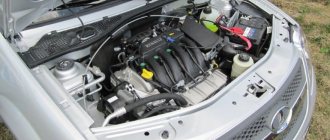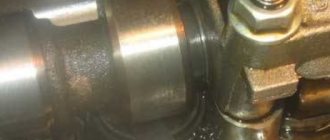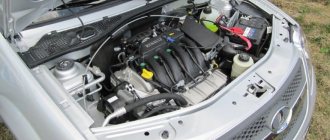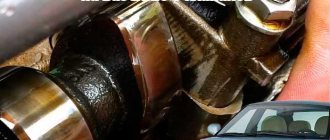Checking and adjusting thermal clearances in the valve drive (8V) Lada Largus
Tools:
- Open-end wrench 10 mm
- Set of flat probes
- adjustable wrench
Notes:
We carry out the work when characteristic clicking knocks appear in the area of the cylinder head with a frequency half the speed of the crankshaft. Basically, knocking occurs as a result of wear of valve mechanism parts and the associated increase in thermal clearances in the valve drive.
Knocks can be heard clearly when the engine is idling.
It is also recommended to check the gaps when the car has driven more than 100 thousand km.
We carry out the work on a cold engine.
Valve arrangement in the cylinder head
1 – row of intake valves; 2 – row of exhaust valves.
1. Remove the cylinder head cover.
2. We remove the upper timing cover and, following the mark on the camshaft gear pulley, set the piston of the first cylinder to TDC at the end of the compression stroke.
Note:
The cylinders are counted from the flywheel.
3. Then we check one by one and, if necessary, adjust the clearances in the drive of the intake and exhaust valves of the 1st cylinder. When checking (in this position of the crankshaft and camshaft), the heels of the rocker arms of the indicated valves should face the backs of the heads - the cylindrical parts of the camshaft cams. In this case, the rocker arms can swing on the axis within the clearance in the drive.
4. Using the flat feeler gauges from the kit, we check the thermal gap between the ends of the valve stem and the adjusting screw.
The gap should be within 0.2 (+0.05 -0.075) mm for intake valves and 0.4 (+0.05 -0.075) mm for exhaust valves. The feeler gauge should move in the gap with little effort.
5. If the gap size (thickness of the feeler gauge) differs from the required value, use a 10 wrench to loosen the tightening of the lock nut of the adjusting screw, holding the screw by the flats (width - 3 mm) with an adjustable wrench.
6. Then, by rotating the adjusting screw, we set the desired gap.
7. Tighten the locknut while holding the adjusting screw with a wrench. We check the gap again and repeat the adjustment if necessary.
8. Consistently turning the crankshaft clockwise each time by the bolt securing the auxiliary drive pulley 180°, we check and, if necessary, adjust the thermal clearances in the valve drive of the 3rd, then the 4th and then the 2nd cylinders.
9. After adjusting the thermal clearances in the valve drive, install the removed parts in the reverse order.
The article is missing:
- High-quality photos of repairs
- Photo of the instrument
Checking and adjusting thermal clearances in the Renault Logan valve drive
- Purpose of gaps
- Necessary tools and knowledge
- Sequence of adjusting Renault Logan valves yourself
Both types of engines are reliable, which is confirmed by reviews from motorists who have owned this car for several years.
The advantage of DOHC 16 V engines is that there is no need to adjust the gaps, since the presence of hydraulic compensators does this automatically.
The K7J and K7M engines feature a SOHC 8V design, a single camshaft and valve in the cylinder head design. An indispensable condition for the stable operation of the power plant is periodic adjustment of the Renault Logan valves
, which can be produced independently.
Adjusting thermal clearances in valves
First, select a level area on which to place the car. Next, use a jack to release one of the front wheels and engage fourth speed. In the engine compartment, remove the air filter, first disconnecting the pipes from it. Next, remove the spark plug high-voltage wires, remove the connector connected to the ignition module and carefully move all the wire harnesses towards the passenger compartment. Be sure to wipe the valve cover: this must be done so that any dirt on it is not transferred inside the mechanism. If you think that the ignition module is bothering you, remove it too. Further steps:
- Transferring the pistons to top dead center (TDC). To achieve this, spin the freed front wheel so that the Latin letter “F2” appears on the edge of the camshaft drive gear. In this case, the piston of the 1st cylinder (you need to count from the flywheel) will be in the TDC position, then both the intake and exhaust valves will be closed.
- Arm yourself with 0.2 and 0.4 mm probes. Using the first of them, check the valve operating on the inlet, the second - on the outlet. The feeler gauge should fit into the gap between the valve and the adjusting screw with little force. If this is not the case, the mechanism should be adjusted.
- Take pliers and tighten the adjusting nut with them. Unscrew the locknut with an open-end wrench to “10”. Achieve the required gap and secure it with a nut.
- The order of adjustment for cylinders is: 1,3,4,2. That is, the rocker should touch the camshaft cam within the smallest radius when viewed from the center of rotation.
- After completing the procedure, carry out a control check of the gaps and, if necessary, adjust those that do not meet the standard.
Adjusting valve clearances
| Author: pakhan74 Published: 2183 days ago (October 6, 2015) Logbook: My Log Category: Uncategorized Edited: 5 times - last October 25, 2016 | +10↑ Votes: 10 |
Today the weather was good, there was nothing to do, I decided to check the gaps. I opened the hood, removed the air vent, and blew off the dust.
I unscrewed eight 8mm bolts and saw the “insides”
I jacked up this drive wheel, I’m right-handed and it’s more convenient to turn with my right foot
I spun the wheel until the letter “Fe” appeared. Then I had to lie, because the shaft was already in the right position. But that doesn't always happen
TDC of the first cylinder corresponds to the letter F on the pulley, or the green mark on the shaft.
I turn the wheel towards myself, adjusting the next edge on the shaft, which corresponds to TDC 3 cylinders
In the same way I adjust the edge without marks - this is the 4th cylinder
And the fourth side with the mark - cylinder 2
A couple of pictures of the timing belt
The image has been reduced. Click to see original.
← How to quickly repair a tubeless tire
Create your own logbook, and you will be able to share with forum members your opinion about Largus, useful developments, installed additional information. equipment and tuning, trips and travel! To create a logbook, you must register on the site.
Tags: valve clearance adjustment, engine
Popular in in-flight magazines
DRL Traveling on Largus Fuel consumption Armrest Mileage Discs Radio To1 First impressions Buying Largus Electrics Covers for Largus Bumper net Modifications HBO Speakers Rear view camera Wipers Interior lighting Brake light Tuning Tires and wheels Check valve Tuning lights Noise insulation Winter tires Rugs Largus DVR Rki-19 Winter operation Roof box PTF Tail lights Izhevsk Car audio Injectors Mudguards Washer reservoir Hood stops Low beam lamp Installing a cabin filter Parking sensors Thresholds Lada Largus LED Carpet covers Floating idle speed Trunk lighting Tinting Trunk shelf Trip to the sea Hood seal Accident Owner's review Fender liners Walkie Talkie Additional Socket Eyeglass case Replacement 5th gear
Comments (20)
| Andrey-174 October 6, 2015 at 08:18 pm +1 | |
|
| Den 73 rus October 6, 2015 at 09:28 pm 0 | |
|
| burnt October 6, 2015 at 09:33 pm 0 | |
|
| Den 73 rus October 6, 2015 at 09:37 pm 0 | |
|
| burnt October 6, 2015 at 09:50 pm 0 | |
|
| burnt October 6, 2015 at 08:31 pm 0 | |
|
| Dima October 6, 2015 at 08:41 pm 0 | |
|
| Andrey-174 October 6, 2015 at 08:48 pm 0 | |
|
| LarqusMen585 October 7, 2015 at 07:21 0 | |
|
| pakhan74 October 6, 2015 at 09:01 pm 0 | |
|
| pakhan74 October 6, 2015 at 08:59 pm 0 | |
|
| burnt October 6, 2015 at 09:18 pm 0 | |
|
| pakhan74 October 6, 2015 at 09:25 pm 0 | |
|
| Andrey-174 October 7, 2015 at 06:59 0 | |
|
| pakhan74 October 7, 2015 at 09:01 0 | |
|
| Kuryan October 7, 2015 at 11:46 am 0 | |
|
| pakhan74 October 7, 2015 at 5:31 pm 0 | |
|
| Kuryan October 8, 2015 at 11:24 am 0 | |
|
| Dima October 8, 2015 at 03:35 pm 0 | |
|
| starryway October 29, 2015 at 10:33 pm 0 | |
|
| Add a comment | RSS comments feed |
Additional comments:
Adjusting valves on Lada Largus
What is valve adjustment? This is an increase or decrease in thermal clearances between the camshaft cam and the part of the mechanism that opens the valve.
If the gap is larger or smaller than necessary, the engine will not be able to operate at full capacity. Because of this, parts will wear out faster, fuel consumption will increase and traction will deteriorate.
TIP: On the Lada Largus you need to adjust the valves every 100 thousand km. mileage If the car runs on gas, then the valves need to be checked more often - every 50-70 thousand km.
INTERESTING: The correct thermal gap is extremely important because metal expands when heated. The valves lengthen slightly as they warm up. If changes in size are not compensated, the combustion chamber loses its tightness.
Adjusting valves on Largus 8 valves instructions
The valve mechanism refers to the engine's gas distribution system. The efficiency of the power unit depends on its correct settings. Cars of the Lada Largus family are equipped with Renault engines with one gas camshaft and 8 valves - the K7M engine - and with two camshafts and 16 valves - the K4M engine. An important parameter for adjusting valves is the gaps between them and the camshaft cam. They must strictly comply with technical regulations. Sixteen-valve K4M engines are equipped with hydraulic compensators, and they do not provide the ability to adjust the clearances.
What happens if you don't adjust the valves?
The main noticeable consequences of incorrect clearances are increased fuel consumption, poor traction and noisy engine operation.
Due to incorrect clearances, the load on the valves and catalyst increases. The valves cool less well and the engine does not operate at full capacity.
Increased and decreased thermal gap
The thermal gap may increase or decrease over time.
With an increased thermal gap, the camshaft hits the valve mechanism. The valves do not close completely and at the wrong time. Because of this, not all of the fuel-air mixture burns, and the engine produces noticeably less power.
With a reduced clearance, the valves do not close tightly, and the combustion chamber ceases to be sealed. Because of this, compression drops. The valves cool less well and may burn out over time. The load on the catalyst also increases.
In both cases the motor does not work properly. Fuel consumption increases, engine power decreases and the load on parts increases.
How do you know when the valves need to be adjusted?
Adjusting the valves is a standard procedure. We recommend that Lada Largus owners contact the service every 100 thousand kilometers if the car runs on gasoline. If gas equipment is installed, then you need to check the gaps more often.
INTERESTING: The main sign of a changed thermal gap: the “clattering” of an unheated engine.
TIP: In critical cases, the “clicking” does not stop even after warming up. This means that the gaps have already changed too much and you need to urgently contact service.
If the engine begins to run louder than usual, then first of all you need to listen to the valves. Quite often, it is the changed thermal clearances that explain the increased noise.
How are valves adjusted?
The procedure takes approximately one and a half hours. During this time, the technician will measure the gaps and adjust them if necessary.
- Remove the valve cover.
- We measure the gaps with a feeler gauge in 0.05 mm increments.
- We adjust thermal gaps.
- Clean the cover and space for the gasket.
- We install a new gasket and put on the cover.
- We tighten the cover in 2 stages with a torque wrench.
- We check the operation of the engine.
In addition to adjusting the gaps, it is important to clean the surfaces and seal the valve cover tightly. Otherwise oil will leak.
After adjusting and installing the cover, it is tightened in 2 stages with a torque wrench. First with a load of 2 Newton meters, then with a load of 10. Thanks to this, the lid stands evenly, without distortions or deformation of the gasket.
Adjusting valves in Logan-Shop St. Petersburg takes only an hour and a half. We recommend periodically listening to a running, cold engine and contacting service as soon as you hear a “clunking” sound. This way you will significantly extend the life of the valves, catalyst and engine as a whole.
Instructions (photo report) for adjusting valves on Renault Logan
When starting engine maintenance, be sure to check and adjust the timing belt tension. We remind you that checking and setting clearances is carried out only on a cold engine. Otherwise, the parameters are overestimated, which is why you will get an unpleasant knock and will be forced to redo everything. For work you will need:
- a set of flat probes;
- open-end wrench “13”;
- tubular wrench or socket to “10”;
- screwdriver;
- pliers;
- jack.
Valve adjustment procedure
- Remove the air filter housing. To do this, disconnect the corrugated air duct pipe and remove the 4 fastening screws.
- Rocking the filter element assembly left and right, remove it from its place and lift it from the side of the right wheel (hereinafter, the standard orientation in the direction of travel of the car is used). By sticking your hand into the resulting opening, release the plastic adsorber tube from the holders. There, remove the breather hose from the fitting located on the valve cover. After this, set the air filter housing aside.
- Remove the ends of the high-voltage wires from the spark plugs, disconnect the ignition module connector and the thin crankcase ventilation hose. Next, move aside the adsorber hose and the wiring harness, which is located at the right end of the valve cover.
- Having gained access to the upper part of the power unit, you should thoroughly blow all places with compressed air. In the future, this will prevent dust and debris from reaching the open gas distribution mechanism.
- Using a tubular wrench, unscrew the valve cover and remove it from the engine. If necessary, the parts installed on it are dismantled, and the part is washed.
- With the car on the parking brake, engage fifth gear. After this, use a jack to hang the right front wheel. This technique will allow you to rotate the camshaft during adjustments.
- The clearances of the engine intake and exhaust valves are adjusted according to the same scheme, so let’s look at the features of this process using the example of the 4th cylinder. The first thing is to ensure maximum clearance between the adjusting bolt and the valve stem. Slowly turning the suspended wheel, control the moment when the camshaft cam moves away from the working part of the lever (rocker) to the maximum distance.
- Check the clearance between the timing lever adjusting bolt and the end of the valve. To do this, insert a probe of the required thickness into the place of their contact. We remind you that the manufacturer recommends a gap of 0.1-0.15 mm for intake valves, and 0.25-0.30 mm for exhaust valves. A tool entering without effort is evidence of an increased gap - because of it, an unpleasant knock is heard when the engine is running. If the probe enters with difficulty or does not enter, then this indicates that the gap is too small - the valve is “clamped”. And finally, a slight tightness at the point of contact of the feeler gauge with the rocker plane on one side and the end of the valve stem on the other is normal - the clearance is adjusted correctly.
- Having found out with the help of a probe that the parameters recommended by the manufacturer are violated, proceed with the adjustment. To do this, use a spanner or open-end wrench “13” to completely loosen the lock nut of the adjusting bolt.
- If the car's mileage is 150-200 thousand km, inspect the mating parts. To do this, unscrew the bolt and inspect the end part. If there is wear, replace it, since the gap cannot be adjusted in this case. In addition, inspect the threads on the parts of the adjusting unit and draw conclusions about their suitability for further use.
- While holding the locknut from turning, rotate the bolt in the desired direction. It is most convenient to do this with a special tool, but if you don’t have one, use pliers. The rocker arm has a right-hand thread, so to increase the gap, turn the screw to the left, and to decrease it, turn it clockwise.
- Having achieved a position of the valve mechanism parts in which the dipstick can be moved with little effort, tighten the locknut. This must be done carefully, holding the adjusting screw itself from turning. Be sure to take into account that during final tightening the bolt rises upward by hundredths of a millimeter, so it is better to make a small adjustment.
- After removing the dipstick, press the rocker arm several times. After this, check the accuracy of the adjustment again.
- Periodically turning the camshaft by rotating the suspended wheel, check and, if necessary, adjust other valves.
- When starting assembly, inspect the valve cover gasket. Replace the heavily compressed part with a new one. In this case, it is better to use metal sealing elements - paper gaskets have not proven themselves to be the best.
- Return the valve cover to its place. After installing the bolts and screwing them in by hand to the maximum depth, proceed to fixing. As with other similar parts, tightening is carried out in several approaches, in a cross-shaped pattern from the center to the periphery. It is better to control the force using a torque wrench - this will ensure reliable fastening and safety of the thread.
- Replace the previously removed wiring harness and adsorber tube. After this, connect the hose from the intake manifold (thin breather) to the valve cover and install the ignition module if it was removed to clean it.
- Replace the air filter housing and attach the crankcase ventilation pipe and corrugated air duct hose to it. After this, proceed with the test run. After starting the engine, there should be no extraneous noise or knocking in its operation. Smooth operation in various operating modes and the absence of vibration at idle speed indicate that the adjustment has been made correctly.
Something else useful for you:


